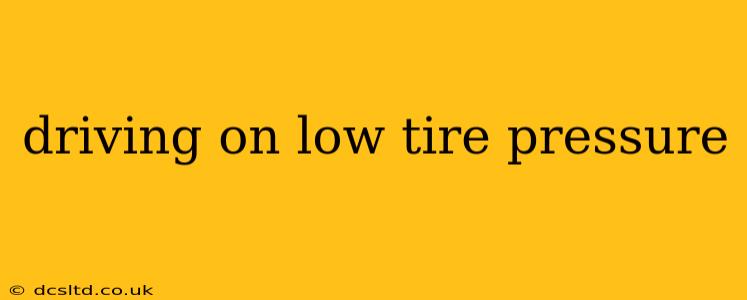Driving on low tire pressure is far more dangerous and damaging than many drivers realize. It significantly impacts your vehicle's handling, fuel efficiency, and tire lifespan, potentially leading to costly repairs or even accidents. This comprehensive guide explores the risks, causes, and solutions associated with driving on under-inflated tires.
What are the risks of driving on low tire pressure?
Driving with low tire pressure presents a multitude of risks, impacting both your safety and your vehicle's well-being. Under-inflated tires increase the risk of:
- Blowouts: This is perhaps the most serious risk. A severely under-inflated tire is more susceptible to sudden failure, especially at higher speeds. A blowout can cause loss of control, leading to accidents.
- Reduced Fuel Efficiency: Under-inflated tires increase rolling resistance, forcing your engine to work harder. This translates to lower gas mileage and increased fuel consumption.
- Uneven Tire Wear: Low tire pressure causes the tire's sidewalls to flex excessively, leading to uneven wear patterns. This reduces tire lifespan and necessitates premature replacement.
- Damage to Wheels and Suspension: The increased stress on the tires and rims due to low pressure can damage the wheels and even impact the vehicle's suspension components.
- Reduced Handling and Braking: Under-inflated tires affect your vehicle's steering responsiveness and braking performance, making it harder to control the car, especially in emergency situations.
- Increased Risk of Aquaplaning: Low tire pressure reduces the contact patch between the tire and the road, making it easier to hydroplane in wet conditions.
What causes low tire pressure?
Several factors contribute to low tire pressure:
- Slow Leaks: Punctures from nails, screws, or other sharp objects are a common cause. Small leaks can develop gradually, leading to a slow loss of air pressure over time.
- Temperature Changes: Tire pressure decreases as temperatures drop and increases as temperatures rise. Significant temperature fluctuations can lead to noticeable pressure changes.
- Improper Inflation: Failing to inflate tires to the recommended pressure (found in your vehicle's owner's manual or on a sticker inside the driver's side doorjamb) is a frequent cause of low tire pressure.
- Valve Stem Issues: Damaged or faulty valve stems can allow air to escape from the tire.
- Tire Age and Wear: Older tires tend to lose air pressure more readily than newer ones, especially if they are worn.
How often should I check my tire pressure?
Ideally, you should check your tire pressure at least once a month, and before any long trip. Checking when the tires are cold (meaning the vehicle hasn't been driven for at least three hours) provides the most accurate reading.
What is the recommended tire pressure?
The recommended tire pressure for your vehicle is specified in your owner's manual or on a sticker located inside the driver's side doorjamb. It is crucial to adhere to this recommendation. Never rely on the pressure indicated on the tire sidewall; this is the maximum pressure the tire can handle, not necessarily the recommended pressure for your vehicle.
How can I fix low tire pressure?
Fixing low tire pressure involves two main steps:
- Inflate your tires: Use a reliable tire pressure gauge to check the pressure and add air using a compressor or air pump until it reaches the recommended level.
- Identify and address the cause: If you consistently experience low tire pressure, investigate potential leaks. Look for embedded objects and check your valve stems. If you suspect a slow leak, consult a tire professional.
What should I do if I experience a tire blowout?
A tire blowout is a serious event. If it happens:
- Maintain a firm grip on the steering wheel: Avoid overreacting.
- Gradually ease off the accelerator: Don't slam on the brakes.
- Steer the vehicle to a safe location: Avoid sudden steering maneuvers.
- Turn on your hazard lights: Warn other drivers.
- Once stopped, call for roadside assistance: Do not attempt to change a flat tire on a busy road.
Driving on low tire pressure is never advisable. Regular checks, proper inflation, and prompt attention to any pressure loss are crucial for maintaining safety, fuel efficiency, and the longevity of your tires. Ignoring low tire pressure can lead to serious consequences, so make tire maintenance a priority.
